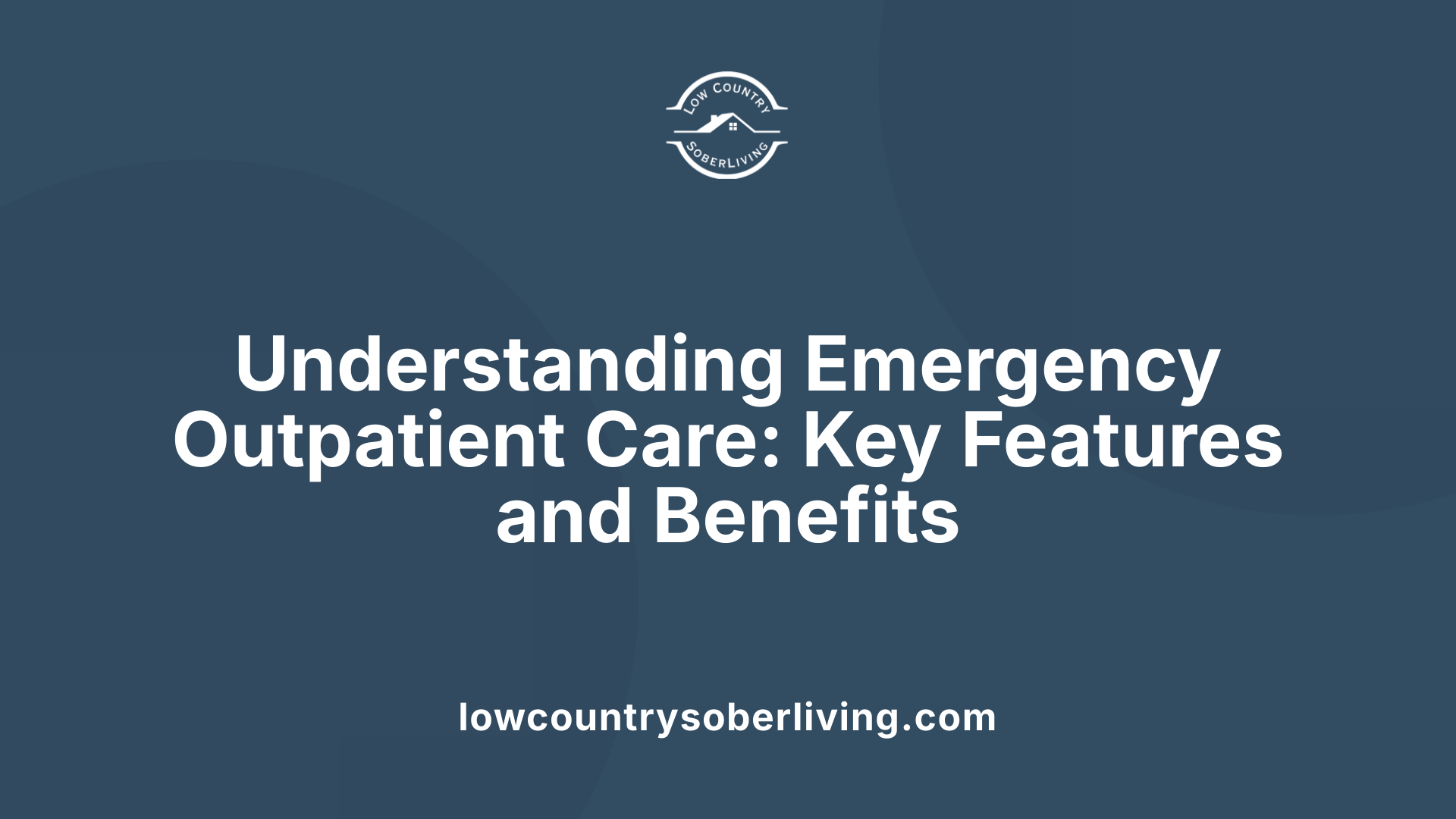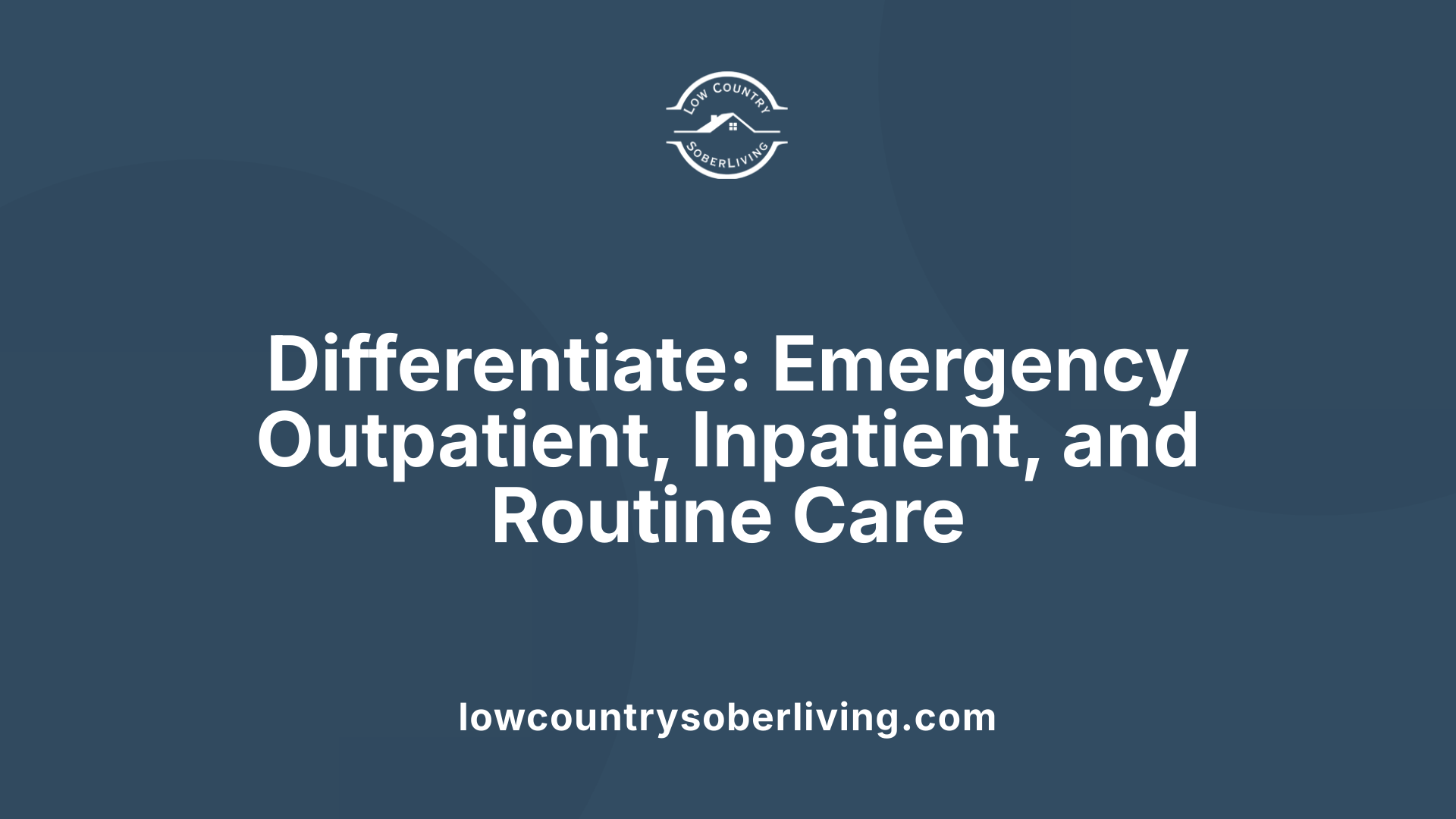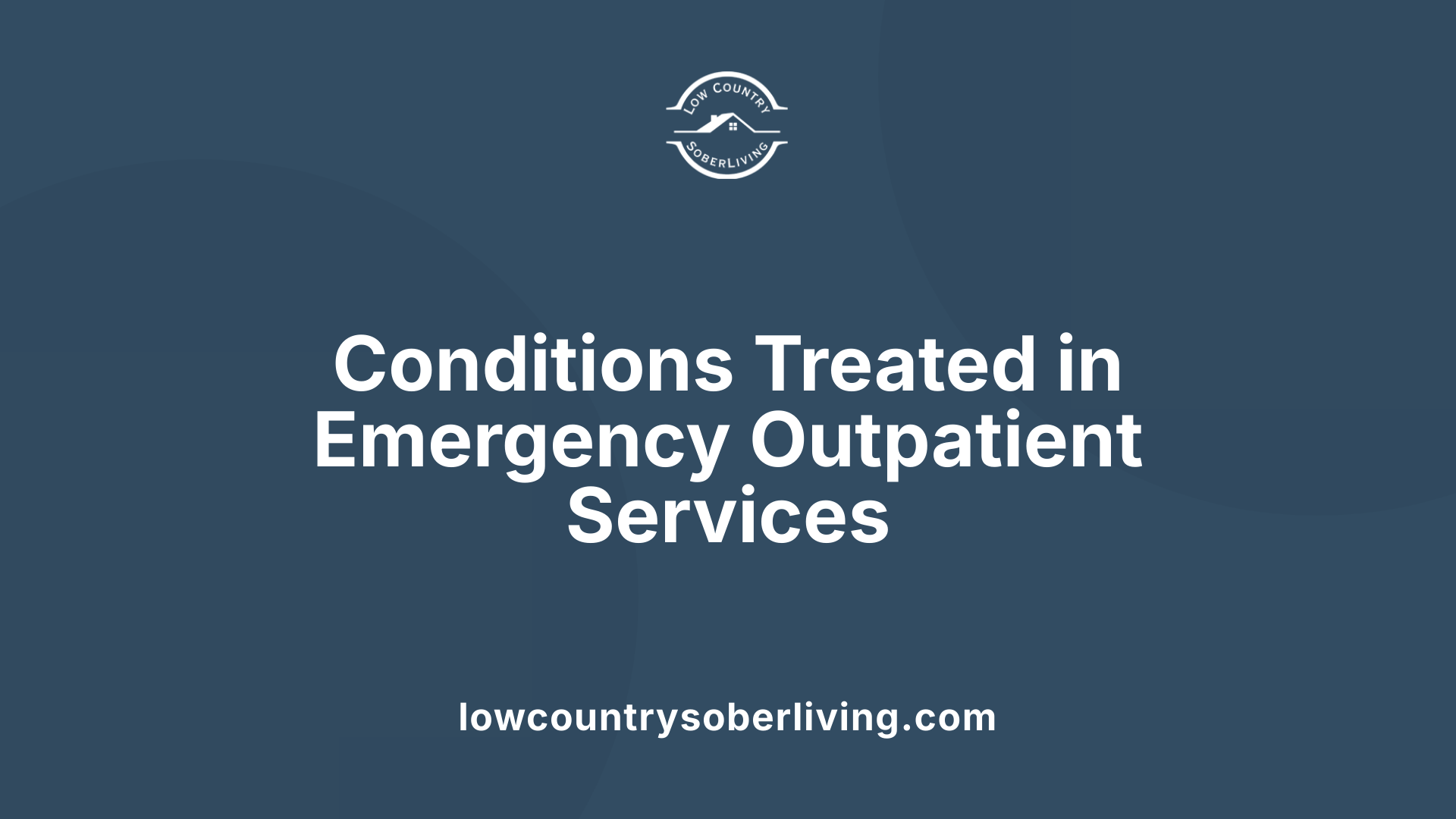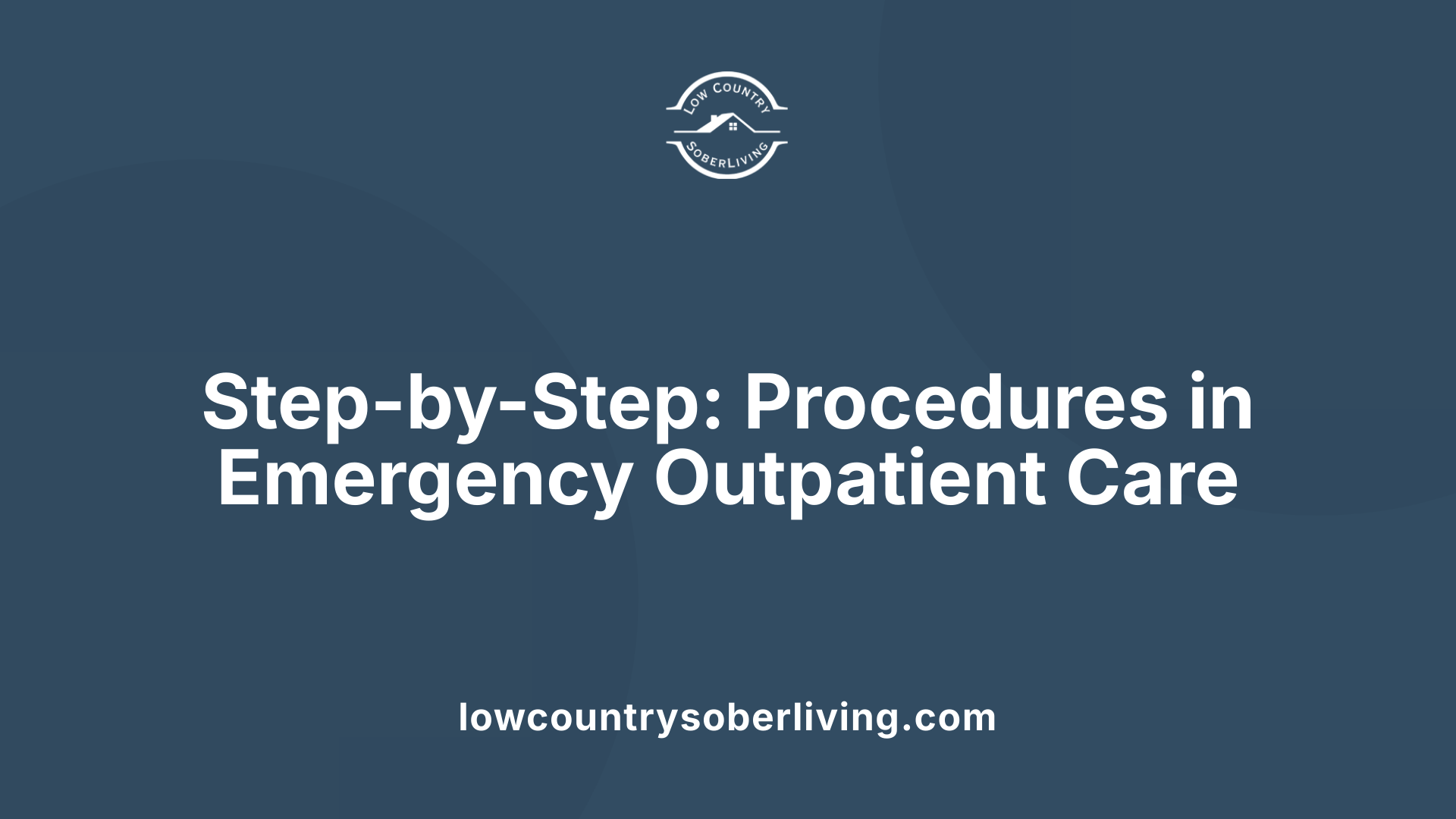An Overview of Emergency Outpatient Treatment
Emergency outpatient treatment plays a vital role in the healthcare system by providing immediate, accessible care for urgent conditions that do not require hospital admission. This approach is designed to address non-life-threatening issues quickly and efficiently, reducing hospital overcrowding and offering cost-effective solutions for patients. Understanding its core features, processes, and distinctions from other forms of care is essential for patients and providers alike.
Defining Emergency Outpatient Treatment and Its Core Features

What is emergency outpatient treatment and what are its core features?
Emergency outpatient treatment provides urgent medical care for individuals experiencing health issues that require immediate attention but not necessarily an extended stay in a hospital. This type of care is typically delivered in specialized clinics or urgent care centers equipped with necessary diagnostic and treatment facilities.
Patients seek emergency outpatient services for conditions like minor injuries, infections, allergic reactions, respiratory issues, or mental health episodes. Unlike emergency rooms that handle severe, life-threatening emergencies, outpatient emergency care focuses on less critical conditions that still need prompt intervention.
The main components of this care include an initial assessment and triage to determine the severity of the condition, followed by diagnostic evaluations such as blood tests or imaging if needed. Medical staff then perform necessary procedures, administer medications, and coordinate referrals to specialists or hospitals if the case requires more intensive treatment.
Benefits of emergency outpatient treatment involve faster access to care, reduced waiting times, lower costs compared to full hospital admissions, and the convenience of treatment without overnight stays. It effectively manages non-critical emergencies, helping to alleviate overcrowding in emergency departments and ensuring patients with urgent but manageable issues receive appropriate attention.
However, this form of treatment is limited in scope. It does not provide inpatient services or extensive procedures that require hospital stays. Also, patients with severe or complex conditions need to be transferred to hospitals capable of providing comprehensive inpatient care.
In summary, emergency outpatient treatment is a valuable healthcare service designed to address urgent, non-life-threatening health concerns efficiently, affordably, and promptly, ensuring better resource utilization and patient outcomes.
The Distinction Between Emergency Outpatient and Other Types of Care

How does emergency outpatient care differ from inpatient or routine outpatient care?
Emergency outpatient care is designed to address urgent, non-life-threatening conditions quickly and efficiently without the need for overnight hospitalization. It typically takes place in specialized clinics or emergency departments that operate around the clock. Patients receive prompt assessments and treatments, such as minor injuries, infections, or allergic reactions, and are usually discharged shortly afterward.
In contrast, inpatient care involves admitting patients to a hospital for an extended stay, often overnight or longer. This type of care is necessary for serious illnesses, major surgeries, or traumatic injuries that require continuous monitoring, complex procedures, or intensive treatment. Patients under inpatient care stay in the hospital, where they receive round-the-clock support, desired for conditions needing close observation.
Routine outpatient care covers scheduled visits that are less urgent. These include preventive checkups, diagnostic tests like blood work or imaging, and minor surgeries that do not require hospitalization. Patients visit the facility, undergo their procedures or consultations, and leave the same day.
While outpatient care—whether emergency or routine—is generally less costly and offers more convenience—waiting times are shorter, and recovery can often happen at home. Inpatient care, however, involves higher costs and greater resource use, suitable only for more severe health issues that demand continuous medical oversight.
Inpatient vs outpatient care
| Aspect | Inpatient Care | Outpatient Care | Emergency Outpatient Care |
|---|---|---|---|
| Duration | Extended stay (overnight or longer) | Same-day visits | Rapid, short-term treatment |
| Hospital stay | Yes | No | Typically no, but may include observation |
| Intensity | High, involves continuous monitoring | Low to moderate, episodic | Urgent but non-critical |
| Suitable for | Serious illnesses, surgeries, injuries | Minor conditions, routine checks | Urgent but non-life-threatening issues |
| Cost | Higher | Lower | Moderate |
Common Conditions Managed Through Emergency Outpatient Services

What conditions are typically treated via emergency outpatient services?
Emergency outpatient services are designed to provide quick, accessible medical care for conditions that demand immediate attention but are not life-threatening. Patients visit urgent care centers or emergency outpatient departments when facing health issues that need prompt intervention.
These services commonly treat:
- Minor injuries such as sprains, cuts, and minor fractures
- Infections like urinary tract infections or skin infections
- Allergic reactions, including mild to moderate cases
- Respiratory issues such as asthma attacks or bronchitis
- Sports injuries and overuse traumas
In these settings, healthcare professionals perform initial assessments, diagnostic tests like X-rays or blood work, and minor procedures such as suturing or wound care. While they can stabilize conditions and manage symptoms, they do not handle complex surgeries or admit patients for extended hospital stays.
In cases of more severe health issues — for example, chest pain, symptoms of stroke, or significant trauma — emergency outpatient services provide initial treatment and rapid transfer to hospitals equipped for advanced care. This approach ensures patients receive timely treatment for urgent conditions while avoiding unnecessary hospital admissions for non-critical cases.
Overall, emergency outpatient services aim to address urgent health concerns efficiently, preventing their escalation and guiding patients towards appropriate further care if needed.
Processes and Procedures in Emergency Outpatient Treatment

What processes and procedures are involved in emergency outpatient care?
Emergency outpatient care follows a structured process designed to provide quick and effective treatment for urgent but non-life-threatening conditions. The first step is triage assessment, where trained staff evaluate the severity of the patient's symptoms to prioritize care. This initial evaluation ensures patients with more urgent needs receive prompt attention.
Once triaged, the patient is registered, and informed consent is obtained for any procedures planned. Immediate diagnostic tests, such as blood work or imaging (X-ray or CT scans), are often performed to assist in diagnosis. For minor injuries or illnesses, procedures like wound suturing, airway management, or administering medications are carried out swiftly.
Throughout treatment, continuous monitoring is essential to ensure the patient remains stable. Based on test results and ongoing assessments, physicians determine whether the patient should be discharged with instructions for follow-up care, transferred for inpatient hospitalization, or need further emergency interventions.
Discharge processes include providing detailed care instructions, prescribing medications, and advising on signs to watch for that may require further medical attention. Communication with the patient and their family is emphasized to ensure understanding.
Furthermore, emergency outpatient departments adhere to established protocols for emergency management, which include preparedness, response, and recovery strategies to maintain safety and quality of care during emergencies. Accurate documentation of all procedures, assessments, and communications is vital for continuity and legal standards.
Overall, these procedures help in delivering efficient, safe, and high-quality outpatient emergency care, ensuring patients receive timely interventions while optimizing hospital resources.
Benefits and Practical Advantages of Emergency Outpatient Care

What are the benefits of choosing emergency outpatient treatment?
Emergency outpatient treatment provides a fast, accessible, and efficient way to address urgent medical issues that are not life-threatening. Patients benefit from quick evaluation and intervention, which helps prevent the progression of conditions like infections, minor injuries, and allergic reactions.
These centers are equipped with necessary diagnostic tools such as X-ray and CT scans, medications, sterile equipment, and lab services, ensuring comprehensive care on-site. The treatment process typically involves prompt triage, evaluation, and therapy, enabling patients to receive care without the need for lengthy hospital stays.
A major advantage is cost savings, as outpatient treatment is generally less expensive than inpatient hospitalization. Patients also enjoy shorter wait times and can often return home within a few hours, making it a convenient option that reduces the burden on hospital emergency departments.
Qualified healthcare professionals, including trained doctors and nurses, staff these centers. They ensure care quality and safety for a range of conditions like minor fractures, infections, and acute illnesses.
Overall, emergency outpatient treatment enhances healthcare delivery by promptly managing urgent, non-life-threatening conditions, improving patient outcomes while conserving hospital resources and reducing costs.
When and Why to Seek Emergency Outpatient Treatment

When and why should someone seek emergency outpatient treatment?
Emergency outpatient treatment is appropriate when a person experiences urgent health issues that are serious enough to require prompt medical attention but do not pose an immediate threat to life. This form of care is suitable for conditions like minor injuries, infections, allergic reactions, asthma attacks, and some mental health concerns such as panic attacks.
Patients with these conditions benefit from rapid assessment and treatment at specialized clinics or urgent care centers. These facilities are staffed with trained healthcare professionals capable of evaluating symptoms, providing necessary treatment, and stabilizing the patient efficiently.
Choosing emergency outpatient care in these situations can prevent condition worsening, reduce complications, and often lower costs compared to full inpatient hospitalization. It also allows individuals to receive quick care without the need for extended hospital stays, making it both accessible and effective.
This type of care is especially valuable when symptoms are distressing but do not demand the extensive resources or monitoring associated with emergency room visits or inpatient services. Knowing when to seek this level of care can lead to better health outcomes and faster recovery.
Accessing Emergency Outpatient Services: The Process and Key Steps

What is the typical process for accessing emergency outpatient services?
When a patient needs urgent medical attention but does not require hospitalization, they typically turn to emergency outpatient services. The process begins with arrival at a specialized clinic, urgent care center, or outpatient emergency department.
The first step is a triage assessment. Trained healthcare professionals evaluate the patient's symptoms and overall condition to determine the urgency of treatment. This prioritization helps ensure that the most severe cases receive immediate attention.
After triage, the patient undergoes registration, where vital information such as personal details, medical history, and insurance particulars are collected. This step ensures proper documentation and billing.
Following registration, healthcare providers assess and treat the patient promptly. Treatment might include administering medications, performing diagnostic tests like X-rays or blood work, or doing minor procedures such as suturing a wound or removing a foreign object.
The goal during this phase is to stabilize the patient's condition and address their urgent concerns effectively.
Post-treatment, the medical team reevaluates the patient's response to care. If necessary, they may provide prescriptions, arrange follow-up appointments, or refer the patient to a full hospital if the condition worsens or requires more extensive intervention.
Finally, patients receive discharge instructions, including guidance on managing their condition at home, warning signs to watch for, and the need for follow-up care.
This entire process emphasizes quick, efficient response to non-life-threatening emergencies, helping patients recover faster while avoiding unnecessary hospital admissions.
Financial Aspects and Cost Considerations in Emergency Outpatient Treatment
What are the cost considerations and expenses associated with emergency outpatient treatment?
The expenses linked to emergency outpatient care are affected by various factors. The level of medical evaluation and management, classified into different billing levels, plays a significant role—more complex cases (levels 4 and 5) tend to be more costly.
Facility fees are another major component. These fees, which cover overhead costs such as staff salaries, advanced technology, and infrastructure, have increased sharply over the years. In fact, from 2004 to 2021, facility fees grew by over 531%, significantly impacting overall treatment costs.
Beyond fee increases, the rising use of high-acuity services, longer observation times, and consolidation within hospital and provider markets add to the expense footprint. Hospitals and healthcare systems are often absorbed in negotiations and billing practices that can be inconsistent, lacking standardization and transparency.
Patients may experience surprise bills due to this lack of clarity, making out-of-pocket costs unpredictable. These systemic factors, including evolving billing models and market consolidation, contribute to higher costs, influencing both affordability and overall healthcare spending.
| Cost Factors | Description | Impact on Expenses |
|---|---|---|
| Evaluation and management levels | Different billing codes based on complexity of care | Higher levels (4 and 5) mean more costs |
| Facility fees | Overhead costs related to hospital infrastructure | Significant growth increases total costs |
| Service complexity | Use of advanced diagnostics or procedures | Elevates overall charges |
| Market and billing practices | Lack of transparency and standardization | Surprises for patients and billing unpredictability |
Overall, understanding these elements helps recognize how emergency outpatient treatment costs can vary widely, influenced by systemic and procedural factors.
In Summary: The Value of Emergency Outpatient Care
Emergency outpatient treatment constitutes an essential component of modern healthcare, providing immediate, efficient, and cost-effective care for urgent but non-critical conditions. It helps alleviate pressure on hospital emergency rooms, ensures timely management of common urgent health issues, and supports community health—especially in rural or underserved areas. By understanding its processes, benefits, and appropriate uses, patients can better navigate the healthcare system, seek appropriate urgent care when needed, and optimize their health outcomes.
References
- What Is an Outpatient Emergency Department - UPMC HealthBeat
- What Is Emergency Outpatient Treatment?
- Outpatient Services In Hospitals Coverage - Medicare
- Emergency Outpatient Deparment | International Goodwill Hospital
- Inpatient vs Outpatient Care: What Is The Difference? | AUC
- What Is Emergency Outpatient Treatment? - Elev8 Centers
- Difference Between Outpatient and Inpatient Medical Services
- Understanding the differences between inpatient vs outpatient care

